Influence of Magnetizing Conditions on Barkhausen Noise in Fe Soft Magnetic Materials after Thermo-Mechanical Treatment
Abstract
:1. Introduction
2. Materials and Methods
3. Results of Experiments and Their Discussion
3.1. Voltage and Frequency Sweeps
3.2. MBN Parameters as a Function of the Magnetising Frequency
4. Conclusions
- -
- The altering magnetising voltage has only a minor role with respect to the MBN emission, and a magnetising voltage of about 5 V is strong enough to unpin the majority of DWs for nearly all investigated LAS;
- -
- The altering magnetising frequency plays a major role, and especially LAS of higher nominal yield strength are very sensitive to the weakening of the altering magnetic field;
- -
- The weakening of the magnetic fields at the higher magnetising frequencies causes that certain fraction of DWs is unpinned (especially in the case of LAS of higher nominal yield strength), which in turn decreases the FWHM of the MBN envelopes, decreases the sensitivity of PP for the differentiation of LAS, and reduces the number of detected pulses;
- -
- LASs of the lower nominal yield strength are less sensitive to the proposal of suitable magnetising conditions, whereas the remarkable difference in MBN can be obtained with respect to the altered magnetising frequency as well as direction of measurements for LAS of higher nominal yield strength.
- -
- MBN in the RD at the magnetising frequency of 750 Hz exhibits the systematic descent (90% decrease) and can be considered as the suitable MBN parameter, employed for this purpose (whereas the MBN in RD at the lower magnetising frequencies, as well as in TD, behave in a non-systematic manner);
- -
- PP in the RD and TD at the lower magnetising frequencies (125 Hz and 250 Hz) are increasing along with the yield strength of LAS (50% increase for 125 Hz in RD and 40% increase in TD, 23% increase for 250 Hz in RD and 16% increase in TD); however, the PP should be combined with the number of MBN pulses (since at the higher magnetising frequencies the PP behave in a non-systematic manner);
- -
- FWHM behaves in a non-systematic manner for all the magnetising conditions and directions;
- -
- the number of all the MBN pulses, at the lower magnetising frequencies (especially 250 Hz), is increasing along with the yield strength of LAS (25% increase for 125 Hz in RD and 23% increase in TD, 37% increase for 250 Hz in RD and 30% increase in TD); however, the number of MBN pulses should be combined with the PP for the magnetising frequency of 125 Hz (the number of the MBN pulses at the higher magnetising frequencies behave in a non-systematic manner);
- -
- applying the background threshold for counting of the MBN pulses number is not beneficial, in this particular case, with respect to materials characterisation.
Author Contributions
Funding
Institutional Review Board Statement
Informed Consent Statement
Data Availability Statement
Conflicts of Interest
References
- Hariprasath, P.; Sivaraja, P.; Balasubramanian, V.; Srinivas, P.; Sridhar, K. Effect of the welding technique on mechanical properties and metallurgical characteristics of the naval grade high strength low alloy steel joints produced by SMAW and GMAW. CIRP J. Manuf. Sci. Technol. 2022, 37, 584–595. [Google Scholar] [CrossRef]
- Boåsen, M.; Lindgren, K.; Öberg, M.; Thuvander, M.; Faleskog, J.; Efsing, P. Analysis of thermal embrittlement of a low alloy steel weldment using fracture toughness and microstructural investigations. Eng. Fract. Mech. 2022, 262, 108248. [Google Scholar] [CrossRef]
- Vuorinen, E.; Hosseini, N.; Hedayati, A.; Kornacker, E.; Fernandez, M.T.; Sanz, J.; Gonzalez, M.I.; Canibalo, E. Mechanical and microstructural evaluation of high performance steel (S700MC) for road restraint systems. Eng. Fail. Anal. 2020, 108, 104251. [Google Scholar] [CrossRef]
- Slovak Technical Standard T010. Barriers of Roads, 1st ed.; Ministry of Transport and Construction of the Slovak Republic: Bratislava, Slovak Republic, 2019. [Google Scholar]
- Bayton, D.A.F.; Long, R.; Fourlaris, G. Dynamic responses of connections in road safety barriers. Mater. Des. 2009, 30, 635–641. [Google Scholar] [CrossRef]
- Zgútová, K.; Neslušan, M.; Kolářik, K.; Šrámek, J. Non-destructive evaluation of stress state of the highway bridge via Barkhausen noise technique. In Proceedings of the 7th International conference on Mechanics and Materials in Design, Albufeira, Portugal, 11–15 June 2017. Progress in Mechanics and Materials in Design. [Google Scholar]
- Karademir, I.; Celik, M.B.; Husem, F.; Maleki, E.; Amanov, A.; Unal, O. Effects of constrained groove pressing, severe shot peening and ultrasonic nanocrystal surface modification on microstructure and mechanical behavior of S500MC high strength low alloy automotive steel. Appl. Surf. Sci. 2021, 538, 147935. [Google Scholar] [CrossRef]
- Ding, H.; Zhu, G.; Xiang, C.; Pei, F.; Chen, J.; Wang, Y.; Chen, Q. Excellent combination of plasticity and ultra-high strength in a low-alloy automotive steel treated by conventional continuous annealing. Mater. Sci. Eng. A 2020, 791, 139694. [Google Scholar] [CrossRef]
- Vervynckt, S.; Verbeken, K.; Lopez, B.; Jonas, J.J. Modern HSLA steels and role of non-recrystallisation temperature. Int. Mater. Rew. 2012, 57, 187208. [Google Scholar] [CrossRef]
- De Ardo, A.J.; Hua, M.J.; Cho, K.G.; Garcia, G.I. On strength of micro alloyed steels: An interpretive review. Mater. Sci. Technol. 2009, 25, 1074. [Google Scholar] [CrossRef] [Green Version]
- Zhang, H.K.; Xiao, H.; Fang, X.W.; Zhang, Q.; Logé, R.E.; Huang, K. A critical assessment of experimental investigation of dynamic recrystallization of metallic materials. Mater. Des. 2020, 193, 108873. [Google Scholar] [CrossRef]
- Jiles, D. Introduction to Magnetism and Magnetic Materials, 3rd ed.; Taylor & Francis Group: New York, NY, USA, 2016. [Google Scholar]
- Chikazumi, S. Physics of Ferromagnetism, 2nd ed.; Oxford University Press: Oxford, UK, 2005. [Google Scholar]
- Cullity, B.D.; Graham, C.D. Introduction to the Magnetic Materials, 2nd ed.; IEEE Press: Piscataway, NJ, USA, 2009. [Google Scholar]
- Dychtoń, K.; Gradzik, A.; Kolek, L.; Raga, K. Evaluation of Thermal Damage Impact on Microstructure and Properties of Carburized AISI 9310 Gear Steel Grade by Destructive and Non-Destructive Testing Methods. Materials 2021, 14, 5276. [Google Scholar] [CrossRef]
- Neslušan, M.; Čížek, J.; Kolařík, K.; Minárik, P.; Čilliková, M.; Melikhová, O. Monitoring of grinding burn via Barkhausen noise emission in case-hardened steel in large-bearing production. J. Mater. Process. Technol. 2017, 240, 104–117. [Google Scholar] [CrossRef]
- Stupakov, A.; Perevertov, O.; Tomáš, I.; Skrbek, B. Evaluation of surface decarburization depth by magnetic Barkhausen noise technique. J. Magn. Magn. Mater. 2011, 323, 1692–1697. [Google Scholar] [CrossRef]
- Ktena, A.; Hristoforou, E.; Gerhardt, G.J.L.; Missell, F.P.; Landgraf, F.J.G.; Rodrigues, D.L.; Albertis-Campos, M. Barkhausen noise as a microstructure characterization tool. Phys. B Condens. Matter. 2014, 435, 109–112. [Google Scholar] [CrossRef]
- Liu, J.; Tian, G.Y.; Gao, B.; Zeng, K.; Zheng, Y.; Chen, J. Micro-macro characteristics between domain wall motion and magnetic Barkhausen noise under tensile stress. J. Magn. Magn. Mater. 2020, 493, 165719. [Google Scholar] [CrossRef]
- Kypris, O.; Nlebedim, I.C.; Jiles, D.C. Measuring stress variation with depth using Barkhausen signals. J. Magn. Magn. Mat. 2016, 407, 377–395. [Google Scholar] [CrossRef]
- Sorsa, A.; Santa-Aho, S.; Wartiainen, J.; Souminen, L.; Vippola, M.; Leviskä, K. Effect of shot peening parameters to residual stress profiles and Barkhausen noise. J. Non-Destruct. Eval. 2018, 37, 10. [Google Scholar] [CrossRef] [Green Version]
- Pitoňák, M.; Ondruš, J.; Minárik, P.; Kubjatko, T.; Neslušan, M. Magnetic Measurement of Zn Layer Heterogeneity on the Flange of the Steel Road Barrier. Materials 2022, 15, 1898. [Google Scholar] [CrossRef]
- Jančula, M.; Neslušan, M.; Pastorek, F.; Pitoňák, M.; Pata, V.; Minárik, P.; Gocál, J. Monitoring of corrosion extent in steel S460MC by the use of magnetic Barkhausen noise emission. J. Nondestruc. Eval. 2021, 40, 69. [Google Scholar] [CrossRef]
- Neslušan, M.; Jurkovič, M.; Kalina, T.; Pitoňák, M.; Zgútová, K. Monitoring of S235 steel over-stressing by the use of Barkhausen noise technique. Eng. Fail. Anal. 2020, 117, 104843. [Google Scholar] [CrossRef]
- Jurkovič, M.; Kalina, T.; Zgútová, K.; Neslušan, M.; Pitoňák, M. Analysis of Magnetic Anisotropy and Non-Homogeneity of S235 Ship Structure Steel after Plastic Straining by the Use of Barkhausen Noise. Materials 2020, 13, 4588. [Google Scholar] [CrossRef]
- Blaow, M.; Evans, J.T.; Shaw, B.A. Magnetic Barkhausen noise: The influence of microstructure and deformation in bending. Acta Mater. 2005, 53, 279–287. [Google Scholar] [CrossRef]
- Gutierez, J.; Barandiarán, J.M.; Hristoforous, E.; Vlachos, D.S. Microstructural evaluation of annealed low-alloy carbon steels with the magnetic Barkhausen noise. Key Eng. Mater. 2015, 644, 258–261. [Google Scholar] [CrossRef]
- Kadavath, G.; Mathew, J.; Griffin, J.; Parfit, D.; Fitzpatrick, M.E. Magnetic Barkhausen noise method for characterisation of low alloyed steel. In ASME 2019 Pressure Vessels and Pipping Conference; American Society of Mechanical Engineers: San Antonio, TX, USA, 2015. [Google Scholar] [CrossRef]
- Saleem, A.; Swanson, D.; Underhill, P.R.; Farrell, S.P.; Krause, T.W. Effect of Temper Embrittlement on Magnetic Barkhausen Noise of Q1N and HY-80 Steels. In Proceedings of the ICBM-13 Conference, Prague, Czech Republic, 23–26 September 2019. [Google Scholar]
- MicroScan 600 Operating Instructions Manual V.5.4b (2015-0-06); Stresstech Group: Jyväskylä, Finland, 2015.
- Vashista, M.; Moorthy, V. Influence of applied magnetic field strength and frequency response of pick-up coil on the magnetic Barkhausen noise profile. J. Magn. Magn. Mater. 2013, 345, 208–214. [Google Scholar] [CrossRef] [Green Version]
- Barkhausen Noise Emission in the Low Alloyed Steels; Technical Report n. 008-2022; University of Žilina: Žilina, Slovakia, 2022.
- Blažek, D.; Neslušan, M.; Mičica, M.; Pištora, J. Extraction of Barkhausen noise from the measured raw signal in high-frequency regimes. Measurement 2016, 94, 456–463. [Google Scholar] [CrossRef]
- Santa-Aho, S.; Vippola, M.; Sorsa, A.; Leiviskä, K.; Lindgren, M.; Lepistö, T. Utilization of Barkhausen noise magnetizing sweeps for case-depth detection from hardened steel. NDT&E Int. 2015, 52, 95–102. [Google Scholar] [CrossRef]
- Sorsa, A.; Leiviskä, K.; Santa-Aho, S.; Lepistö, T. Quantitative prediction of residual stress and hardness in case-hardened steel based on the Barkhausen noise measurement. NDT&E Int. 2012, 46, 100–106. [Google Scholar] [CrossRef]
- Šrámek, J.; Neslušan, M.; Bahleda, F.; Zgútová, K.; Schenk, P. Influence of sample size and magnetizing voltage on Barkhausen noise during bending and uniaxial tensile test. Acta Phys. Pol. A 2020, 137, 640–643. [Google Scholar] [CrossRef]
- Varga, R. Domain Walls and Their Dynamics, 1st ed.; Pavol Jozef Šafárik University: Košice, Slovakia, 2014; pp. 32–41. [Google Scholar]


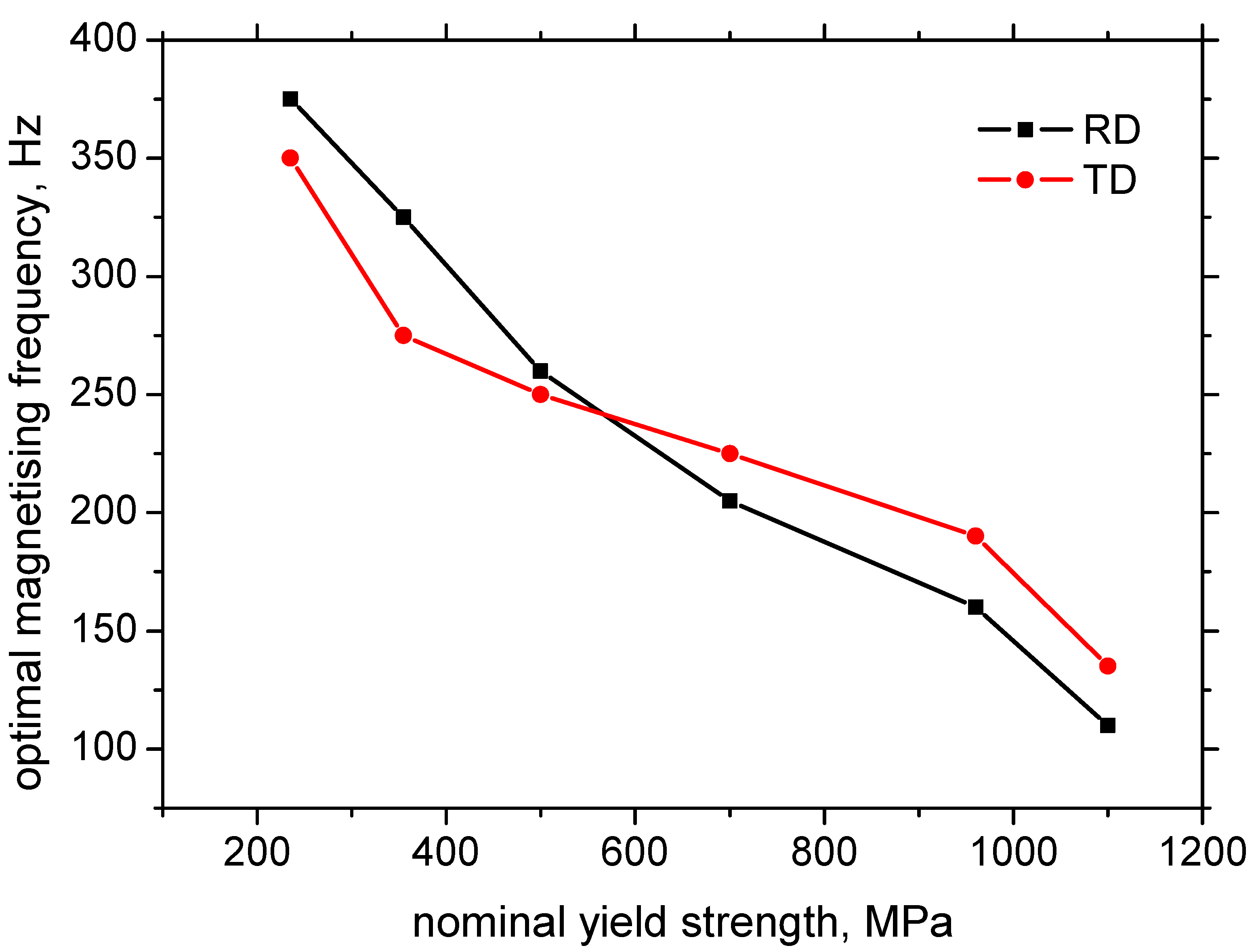
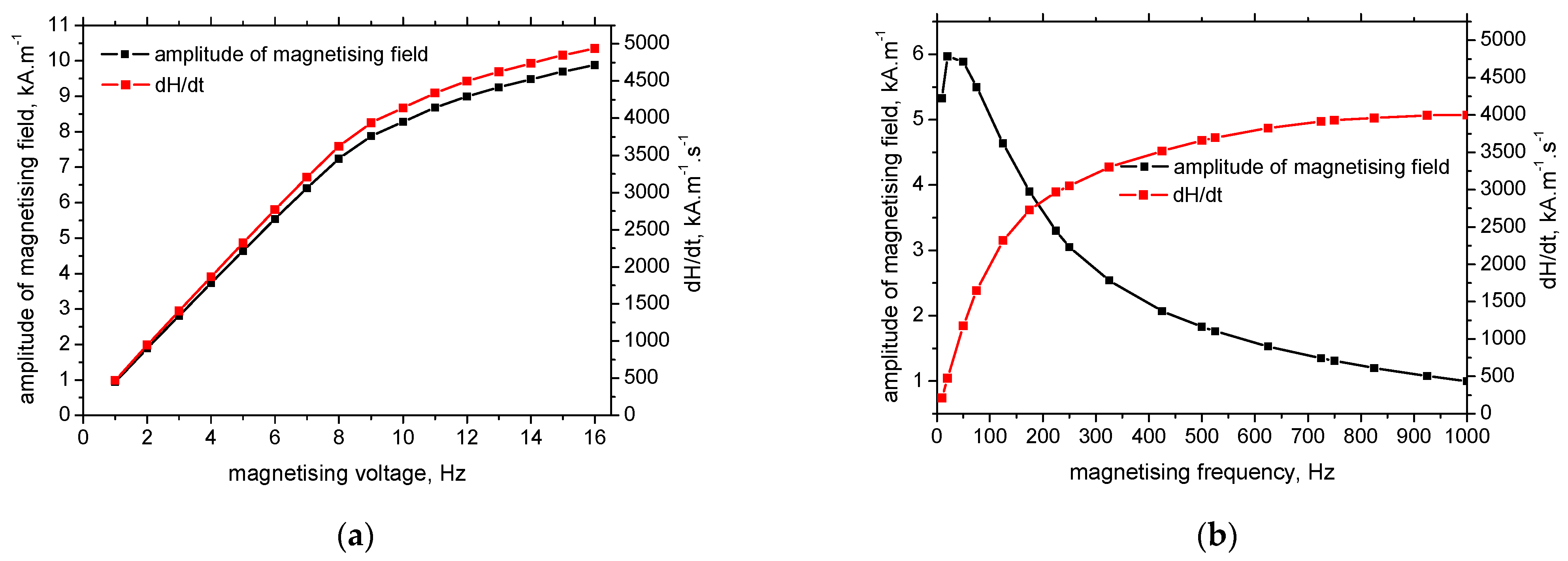
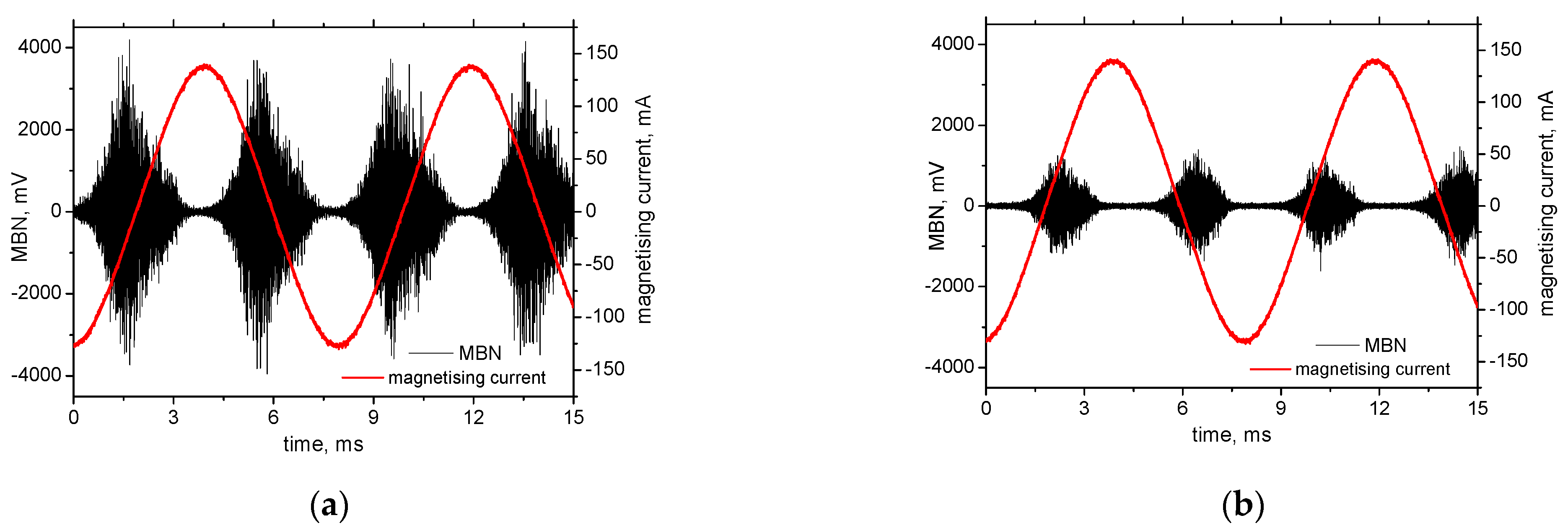
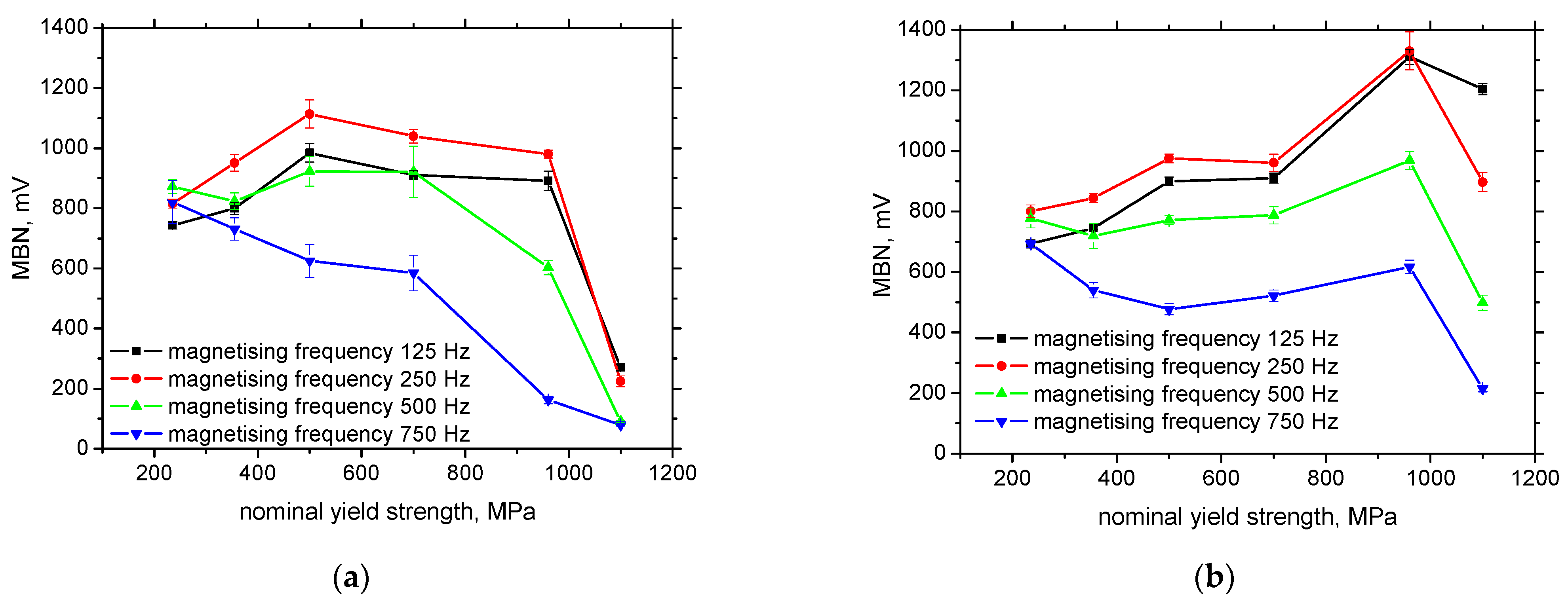
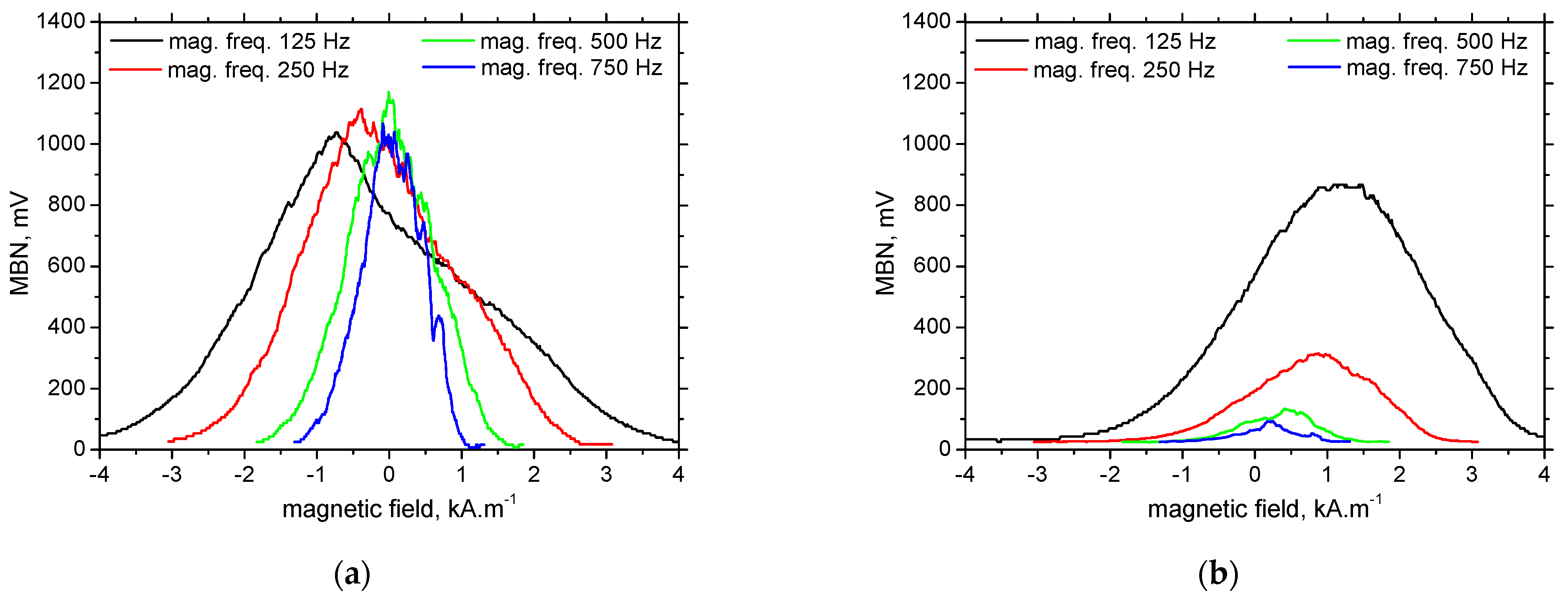
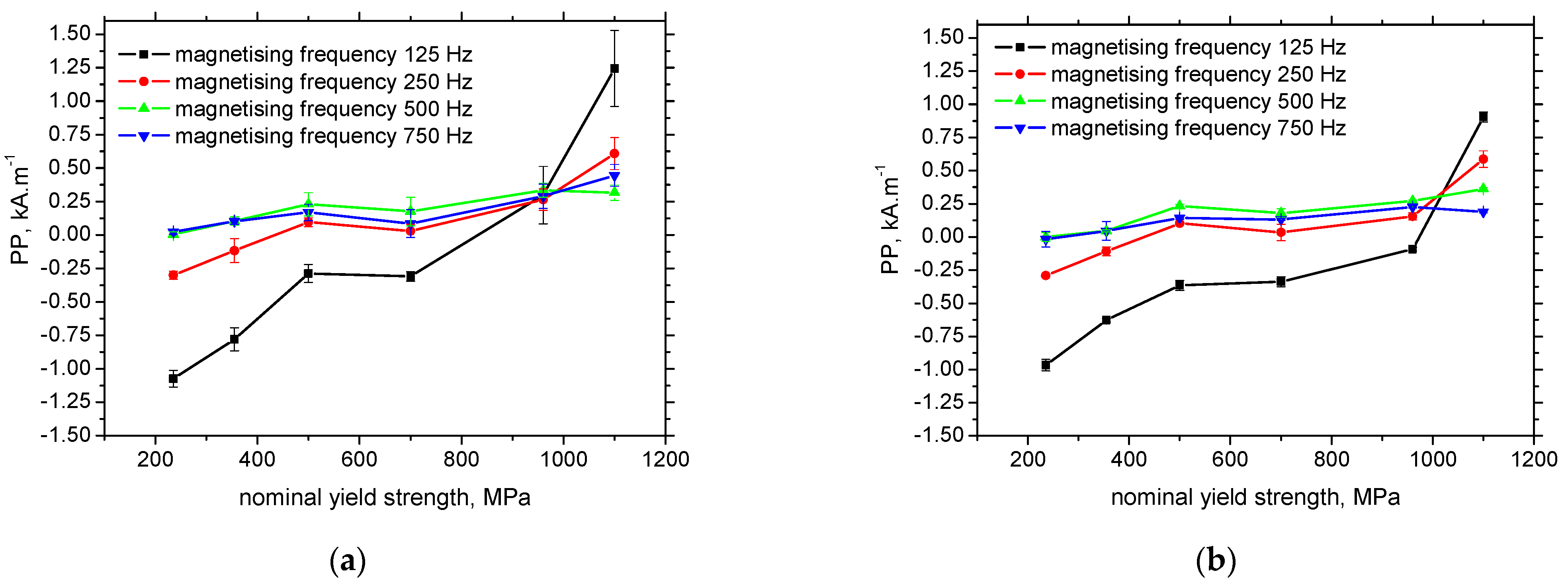
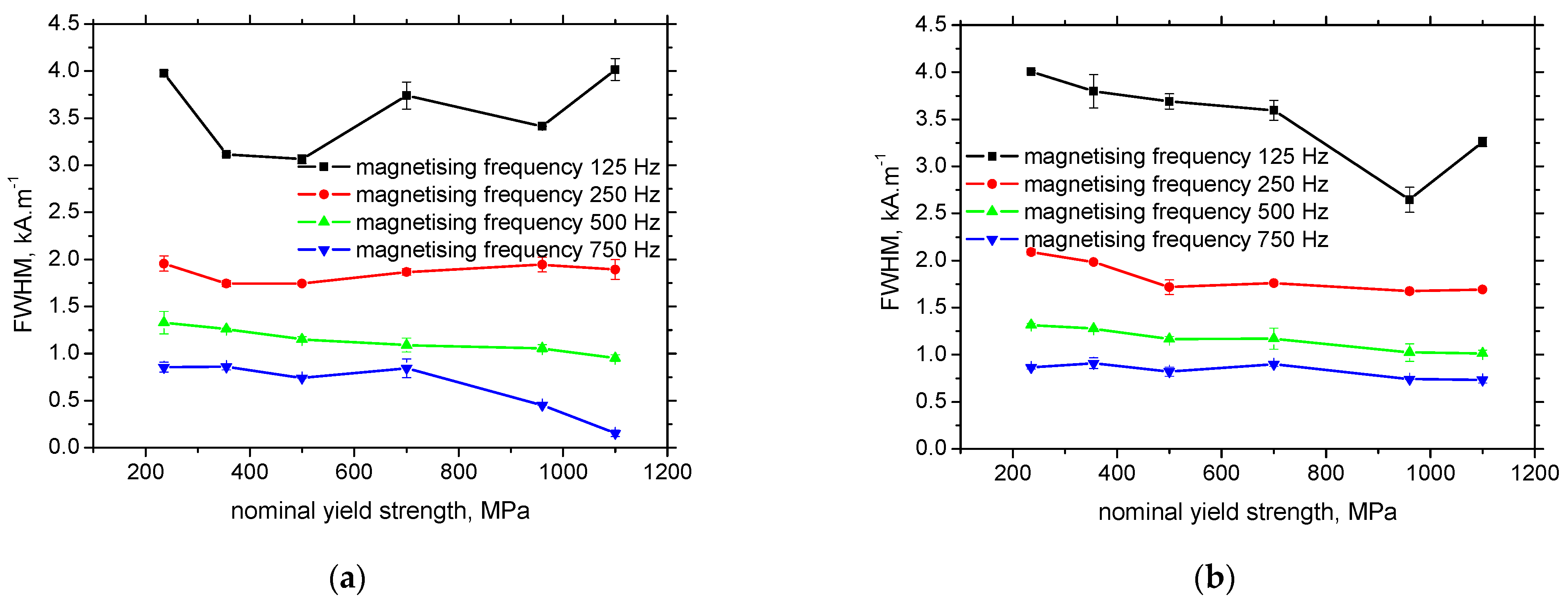
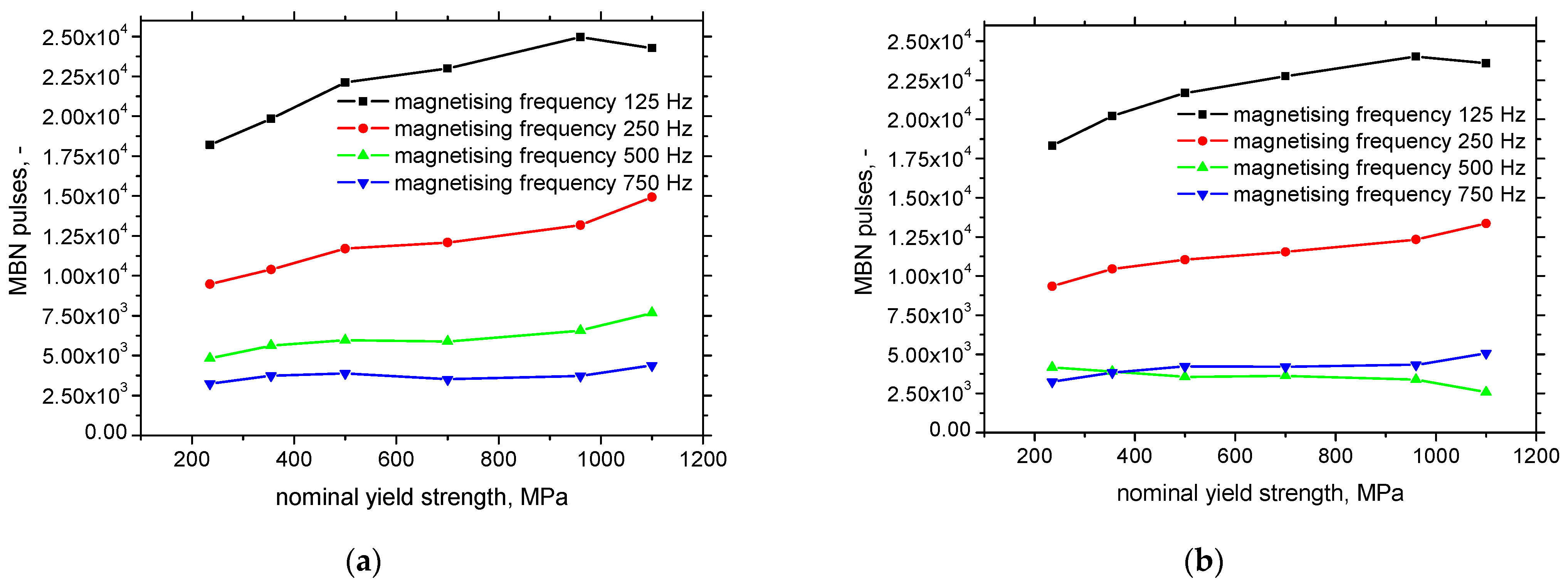
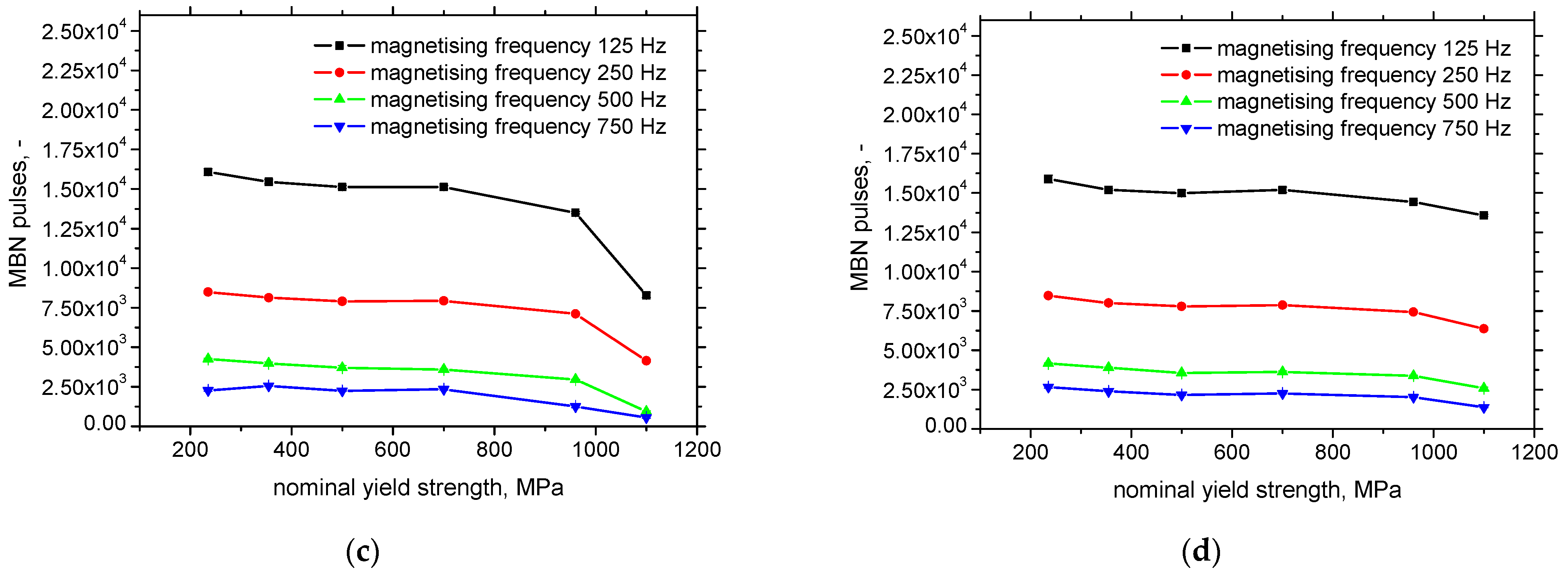
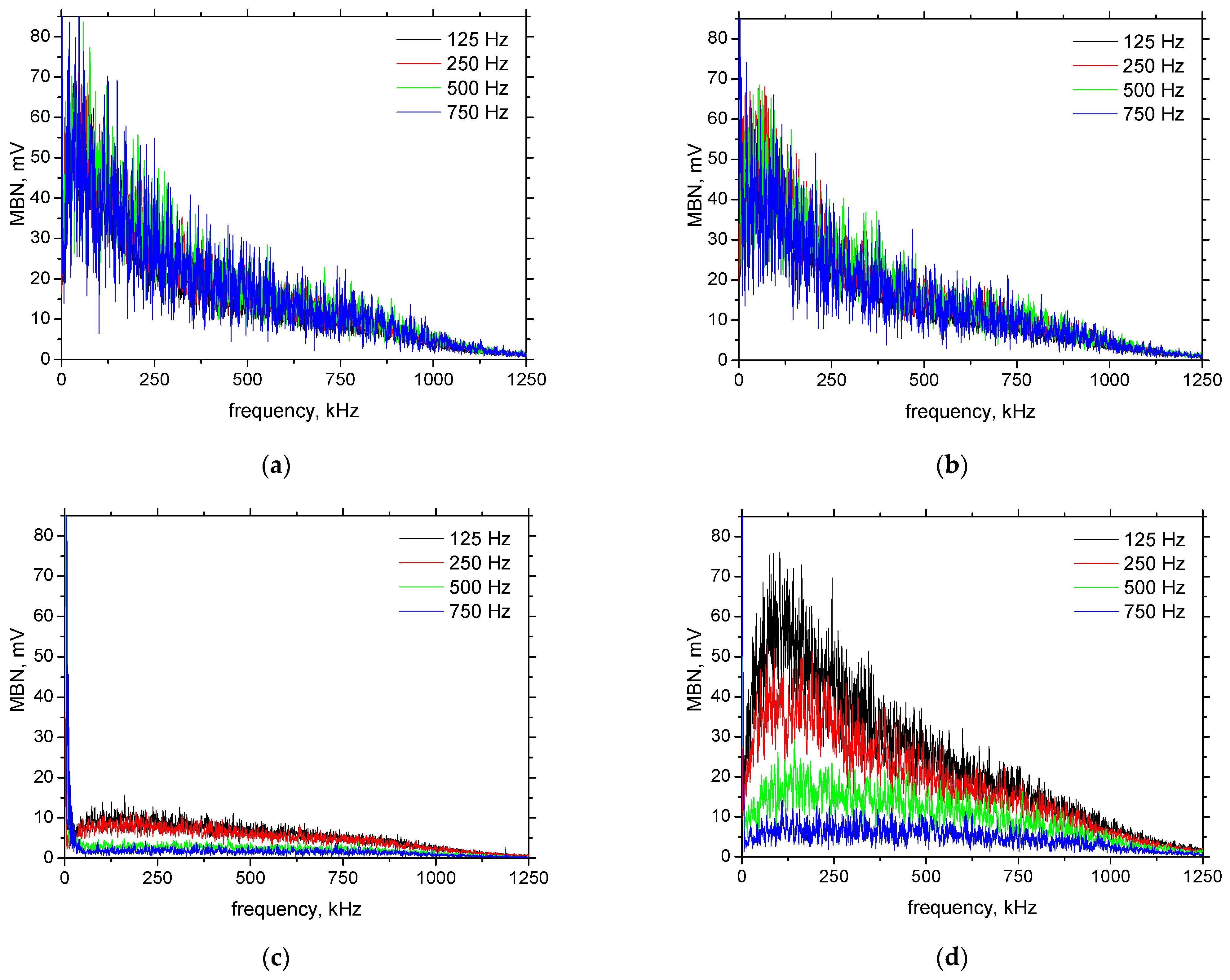
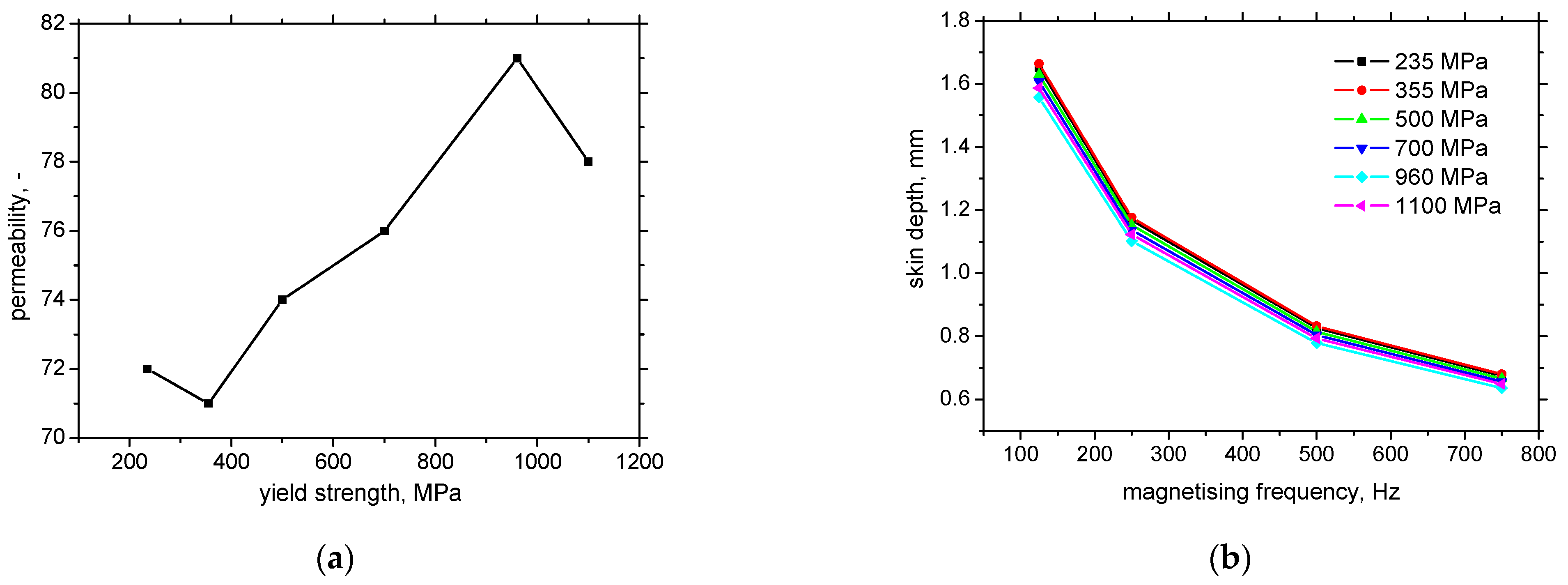
| LAS | Microstructure | Residual Stresses, MPa | Chemical Composition, Weight % | HV1 | ||||
|---|---|---|---|---|---|---|---|---|
| RD | TD | C | Mn | Si | Nb + Ti | |||
| S235 | Ferrite | −45 ± 33 | −38 ± 32 | 0.22 | 1.6 | 0.05 | - | 125 ± 8 |
| S355 | Ferrite | 147 ± 15 | 133 ± 18 | 0.07 | 0.7 | 0.01 | 0.05 | 158 ± 2 |
| MC500 | Ferrite | 315 ± 7 | 256 ± 18 | 0.08 | 1.1 | 0.02 | 0.1 | 214 ± 5 |
| MC700 | Ferrite + bainite | 211 ± 40 | 126 ± 20 | 0.05 | 1.8 | 0.02 | 0.21 | 265 ± 5 |
| MC960 | Bainite + martensite | 21 ± 12 | 25 ± 6 | 0.12 | 1.3 | 0.25 | 0.12 | 362 ± 16 |
| MC1100 | Martensite + bainite | −27 ± 18 | 30 ± 5 | 0.15 | 1.8 | 0.5 | - | 432 ± 14 |
| rms, mV | PP, kA.m−1 | FWHM, kA.m−1 | MBN Pulses-All | MBN Pulses–above 100 mV | ||||||
|---|---|---|---|---|---|---|---|---|---|---|
| RD | TD | RD | TD | RD | TD | RD | TD | RD | TD | |
| 125 Hz | x | x | +50% | +40% | x | x | +25% | +23% | x | x |
| 250 Hz | x | x | +23% | +16% | x | x | +37% | +30% | x | x |
| 500 Hz | x | x | ↑? | ↑? | ↓? | ↓? | x | x | x | x |
| 750 Hz | - 90% | x | ↑? | ↑? | x | x | x | x | x | x |
Publisher’s Note: MDPI stays neutral with regard to jurisdictional claims in published maps and institutional affiliations. |
© 2022 by the authors. Licensee MDPI, Basel, Switzerland. This article is an open access article distributed under the terms and conditions of the Creative Commons Attribution (CC BY) license (https://creativecommons.org/licenses/by/4.0/).
Share and Cite
Neslušan, M.; Zgútová, K.; Pitoňák, M.; Kajánek, D. Influence of Magnetizing Conditions on Barkhausen Noise in Fe Soft Magnetic Materials after Thermo-Mechanical Treatment. Materials 2022, 15, 7239. https://doi.org/10.3390/ma15207239
Neslušan M, Zgútová K, Pitoňák M, Kajánek D. Influence of Magnetizing Conditions on Barkhausen Noise in Fe Soft Magnetic Materials after Thermo-Mechanical Treatment. Materials. 2022; 15(20):7239. https://doi.org/10.3390/ma15207239
Chicago/Turabian StyleNeslušan, Miroslav, Katarína Zgútová, Martin Pitoňák, and Daniel Kajánek. 2022. "Influence of Magnetizing Conditions on Barkhausen Noise in Fe Soft Magnetic Materials after Thermo-Mechanical Treatment" Materials 15, no. 20: 7239. https://doi.org/10.3390/ma15207239





